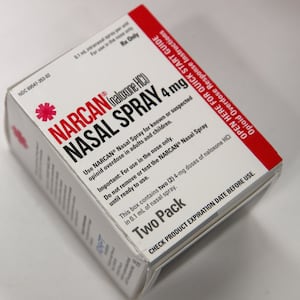Kevin Pearson used to face a hard choice any time he tried to get clean from heroin and found himself approaching a painful withdrawal: He could try to get on Suboxone or methadone, two of the medications that keep opioid users from craving drugs or withdrawing under what’s called medically assisted treatment (MAT); or he could go back to using illicit drugs. The choice might seem easy to someone who didn’t know better. Why wouldn’t Pearson—or any of the 2.1 million Americans suffering from opioid addiction—just choose the safe, effective option of MAT?
According to the 38-year-old, it’s not that easy. Despite the well-established efficacy of MAT, it’s not always easily accessible. Pearson pointed specifically to “how much of a pain in the ass it is just to get a doctor’s appointment.” It’s usually a two-week wait, he told The Daily Beast, and users can find themselves detoxing in the waiting room. Their insurance might not cover MAT, the nearest prescriber may operate too far from where they live to make daily or weekly trips feasible, and their pharmacist could refuse to fill a prescription for Suboxone. Friends, family members, and 12-step programs could also be against MAT and discourage someone from seeking it out. Choosing methadone or Suboxone over street drugs isn't exactly an easy choice for someone who has a finite amount of time until they get hit with debilitating body aches, diarrhea, exhaustion, and vomiting.
Or at least, it wasn’t until Suboxone became available through telehealth and the COVID-19 pandemic led to a boom for the companies that offer it.
ADVERTISEMENT
The pandemic decimated many of America’s industries, but telehealth was not one of them. Lawmakers quickly suspended some of the restrictions around dispensing telehealth-prescribed medication. Those who manage their substance use disorders using MAT options have typically faced a number of barriers to accessing necessary medicine. New allowances for telemedicine prescription suddenly eased many of them.

BOSTON, MA - APRIL 27: A patient displays his Suboxone prescription following his appointment at the Substance Use Disorders Bridge Clinic at Massachusetts General Hospital in Boston on April 27, 2018. The patient takes Suboxone, a medicine that contains buprenorphine and naloxone, to treat his substance use disorder. He said he had been addicted to Opioids for 10 years but has been drug free since he started taking Suboxone nearly 2 years ago.
Craig F. Walker/The Boston Globe via Getty ImagesThose rule changes came in at a crucial time. In 2020, a record-breaking 93,000 deaths were attributed to drug overdoses. The most recent data, from 2019, shows that only 22 percent of Americans with opioid use disorder get treatment of any kind. Over 10 million people in the U.S. misused opioids that year and current data suggests over 2 million have an opioid use disorder. Those numbers are worsening, especially as fentanyl, a powerful synthetic opioid, continues to infiltrate the illicit drug supply.
As the opioid crisis has gotten worse, MAT’s star has been on the rise. Methadone is the MAT gold standard for treating opioid use disorder, but it is very tightly regulated and not at all accessible through telehealth. Alternatives like buprenorphine (usually provided in the form of Suboxone) and naltrexone, however, are much easier to prescribe even by telehealth. Beyond the medications, successful MAT also integrates counseling and behavioral therapies to provide well-rounded care.
But how does that work online? Everything from erectile dysfunction medication to birth control can be obtained through telehealth, but those treatments don’t depend on a careful combination of medicine and therapy. Numerous MAT apps have popped up in recent years and some, at least, are working to replicate the counseling component virtually.
Lisa McLaughlin is a co-founder of WorkIt Health, a telehealth company that serves drug and alcohol users in 10 states, with plans to be national by 2023. The company offers treatments for a variety of problematic use disorders, but McLaughlin says she and her co-founder realized over time “one of the key pieces of the puzzle that was missing was the psychiatry piece.” She told The Daily Beast that from what she’s seen, those who have the most successful recoveries are those who also have underlying conditions treated. WorkIt Health, she said, approaches treatment for depression, anxiety, bipolar disorder, ADHD and more “within the same treatment experience” as substance use disorders, “which leads to really great outcomes.”
One telehealth MAT patient named Cody, who asked his last name not be printed for privacy reasons, told The Daily Beast that while he misses the “stability” of in-person clinic visits, he is grateful for any expansion in MAT access because harm reduction is an objective good. “A lot of people will question it because it’s like, ‘Oh, you’re getting off one opioid and just getting a prescription opioid. What’s the difference?’ Well, the difference is it takes you out of those drug-procuring habits,” he said. “You’re not walking the street to go cop drugs illegally. When you get a script, you know exactly how much you’re taking.”
Big companies like CVS Health Ventures, First Mark Capital, and BCBS Venture Fund are shelling out to fund McLaughlin and McIntosh’s vision (the company recently closed a $118 round of investment). Yet stigma is still strong. CVS itself is being sued in North Carolina by another telehealth MAT company, Bupe.me, for allegedly violating patients’ rights under the Americans With Disabilities Act, since its pharmacists around the country can—and do—refuse to fill prescriptions for MAT drugs, citing a discomfort with telehealth prescriptions. Patients routinely point to noncompliant pharmacists as one of the bigger barriers to MAT.
(A spokesperson for CVS said, “The allegations in the lawsuit have no merit and we are vigorously defending ourselves against it. North Carolina law is clear that pharmacists have the right to decline to fill prescriptions for controlled substances in the exercise of their professional judgment. Nothing in the Americans with Disabilities Act compels pharmacists to fill prescriptions for controlled substances when it conflicts with their professional judgment and corresponding responsibility.”)

TAUNTON, MA - MAY 10: People are seen outside a methadone clinic that is located across from Taunton Police Station on Friday, May 10, 2019, in Taunton, MA. The clinic administer daily Methadone doses.
Salwan Georges/The Washington Post via Getty ImagesStephen Loyd, medical director of Cedar Recovery Center and former medical director for Tennessee’s substance abuse services division, started providing MAT by telehealth during the pandemic and quickly noted its pros and cons. He told The Daily Beast he found it “ironic” that pharmacies that might have no issue filling therapeutic opioid prescriptions would call him to double-check a prescription for the drugs that keep his patients away from them.
“It’s like that because these people are expendable,” he fumed, pointing out that if any other disease had a death rate increasing similarly to the overdose crisis “there would be a march on Washington.” That doesn’t happen, he said, because of stigma—which is why, for all the frustrations that come with telehealth MAT, the privacy, convenience, and savings it affords are invaluable. Loyd is in recovery himself, but as a doctor, he had access to 90 days of high-quality treatment that’s completely abstinence-based, a rigorous support system, a six-figure income, and five years of after-care and follow-up. “Nobody else gets that.”
The situation in pharmacies has gotten so dire that Ankit Gupta, CEO of Bicycle Health, told The Daily Beast that his telehealth MAT company has started keeping an internal list of hostile pharmacies and directing patients away whenever possible.
Sometimes, though, there are no other options; one of the major barriers to MAT has always been a lack of prescribers or willing pharmacists in rural areas. Telehealth can make prescribing slightly easier for those who don’t live in major urban hubs, but that only addresses part of the problem. Some companies have begun taking the extraordinary step of shipping buprenorphine straight to patients’ homes.
Pearson has used three different telehealth MAT companies. He told The Daily Beast the first doctor who ever prescribed him Suboxone years ago—and in person—was against its use entirely and was an ardent believer in 12-step programs. The doctor even displayed his own five-year sobriety token.
“He was like, ‘Dude, there’s no way you’re gonna get sober with this,’” Pearson recalled. Pearson tried 12-step programs, too, but, he said, “it just got on my nerves.” MAT is the approach that has worked most consistently for him, though he’s been frustrated by barriers ranging from disorganized billing departments to certain programs not accepting his insurance. Even when MAT is clearly the best option for a person with a substance use disorder, it can be difficult to access.
“There are some people who go out in the woods with their Bible and blue jeans and T-shirts and stay six months and that’s their treatment and they do good with that,” said Loyd. “I don’t have a problem with it. But I do have a problem with it when you tell me that’s the only way.”
Still, telehealth isn’t perfect, and Loyd does think some companies “look at the behavioral health component of this as a checkbox. And it’s bullshit,” he said. “I love telehealth, but people change with behavioral change. Addiction is not about recovery. Addiction is about relationships and community and it’s hard to do that on an app where you never see anybody or have a personal interest in what’s going on in their lives.”
Still, the pandemic has forced much of the world to acclimate to virtual meetings and find ways to make the most of it. Whether the option is perfect or not, telehealth will only grow bigger—including as a recovery tool for those struggling with opioids. WorkIt, Bicycle, Bupe.me, and all of the companies in the space are expanding rapidly. In March of this year, a bipartisan group of congressional representatives re-introduced the Telehealth Response for E-prescribing Addiction Therapy Services—or TREATS—Act to support that expansion. The TREATS Act would extend the pandemic-era flexibilities that enabled telehealth MAT to reach so many patients by making key waivers permanent, including the ability to prescribe MAT and the ability to bill Medicare for audio-only telehealth services.
Brian Clear, Bicycle Health’s medical director, told The Daily Beast that in his experience, “patients are more open and more comfortable via telehealth. It’s just kind of counterintuitive, but we can actually—I believe this very firmly—we can build better relationships with patients via telehealth than I’m used to being able to build in person.”







